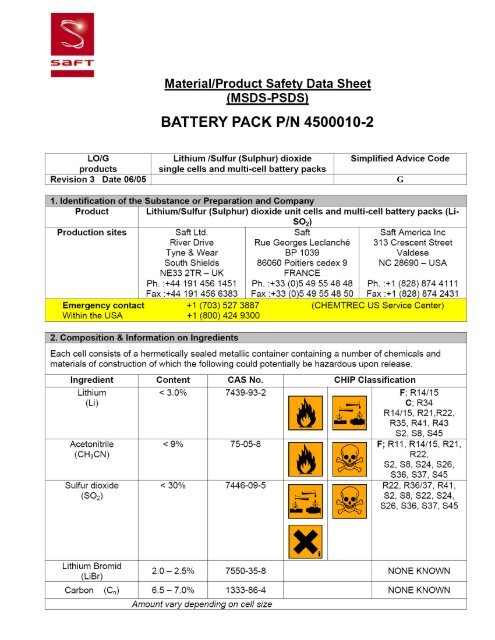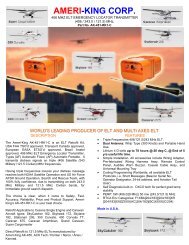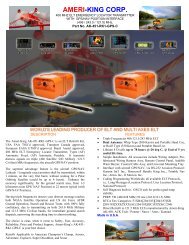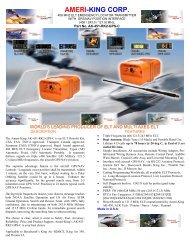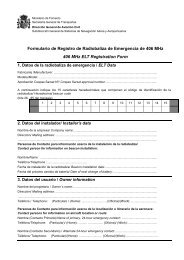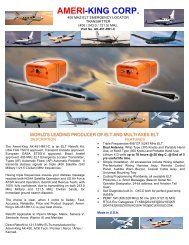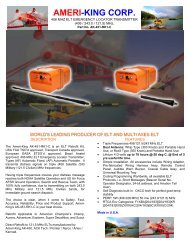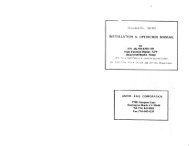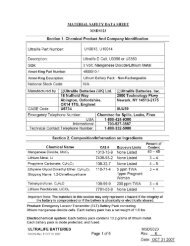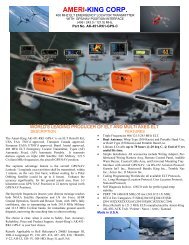MSDS for Battery Pack 4500010-2 LiSO2 Lithium - Ameri-King.com
MSDS for Battery Pack 4500010-2 LiSO2 Lithium - Ameri-King.com
MSDS for Battery Pack 4500010-2 LiSO2 Lithium - Ameri-King.com
- No tags were found...
Create successful ePaper yourself
Turn your PDF publications into a flip-book with our unique Google optimized e-Paper software.
3. Hazards IdentificationDo not short circuit, recharge, puncture, incinerate, crush, immerse, <strong>for</strong>ce discharge or expose totemperatures above the declared operating temperature range of the product. Risk of fire or explosion.The <strong>Lithium</strong>-Sulfur dioxide batteries described in this Product Safety Data Sheet are sealed unitswhich are not hazardous when used according to the re<strong>com</strong>mendations of the manufacturer.Under normal conditions of use, the electrode materials and electrolyte they contain are not exposedto the outside, provided the battery integrity is maintained and seals remain intact. Risk of exposureonly in case of abuse (mechanical, thermal, electrical) which leads to the activation of safety valvesand/or the rupture of the battery containers. Electrolyte leakage, electrode materials reaction withmoisture/water or battery vent/explosion/fire may follow, depending upon the circumstances.4. First Aid MeasuresInhalationSkin ContactEye ContactIngestionFurther TreatmentRemove from exposure, rest and keep warm. In severe cases obtainmedical attention.Wash off skin thoroughly with water. Remove contaminated clothing andwash be<strong>for</strong>e reuse. In severe cases obtain medical attention.Irrigate thoroughly with water <strong>for</strong> at least 15 minutes. Obtain medicalattention.Wash out mouth thoroughly with water and give plenty of water to drink.Obtain medical attention.All cases of eye contamination, persistent skin irritation and casualtieswho have swallowed this substance or been affected by breathing itsvapours should be seen by a Doctor.5. Fire Fighting MeasuresCO2extinguishers or copious quantities of water or water-based foam can be used to cool downburning Li-SO 2 cells and batteries, as long as the extent of the fire has not progressed to the point thatthe lithium metal they contain is exposed.Do not use <strong>for</strong> this purpose sand, dry powder or soda ash , graphite powder or fire blankets.Use only metal (Class D) extinguishers on raw lithium.Extinguishing Media6. Accidental Release MeasuresUse water or CO 2 on burning Li-SO 2 cells or batteriesand class D fire extinguishing agent only on raw lithiumRemove personnel from area until fumes dissipate. Do not breathe vapours or touch liquid with barehands.If the skin has <strong>com</strong>e into contact with the electrolyte it should be washed thoroughly with water.Sand or earth should be used to absorb any exuded material, seal leaking battery and contaminatedabsorbent material in plastic bag and dispose of as Special Waste in accordance with localregulations.<strong>MSDS</strong> Li-SO 2Rev. 3 June 2005
7. Handling and StorageHandlingDo not crush, pierce, short (+) and (-) battery terminals with conductive (i.e.metal) goods. Do not directly heat or solder. Do not throw into fire.Do not mix batteries of different types and brands. Do not mix new and usedbatteries. Keep batteries in non conductive (i.e. plastic) trays.StorageStore in a cool (preferably below 30°C) and ventilated area, away frommoisture, sources of heat, open flames, food and drink. Keep adequateclearance between walls and batteries. Temperature above 90°C may resultin battery leakage and rupture. Since short circuit can cause burn, leakageand rupture hazard, keep batteries in original packaging until use and do notjumble them.Other<strong>Lithium</strong>-Sulfur dioxide batteries are not rechargeable and should not betentatively charged.Follow Manufacturers re<strong>com</strong>mendations regarding maximum re<strong>com</strong>mendedcurrents and operating temperature range.Applying pressure on de<strong>for</strong>ming the battery may lead to disassemblyfollowed by eye, skin and throat irritation.8. Exposure Controls & Personal ProtectionOccupational Compoundexposure standard Sulfur (Sulphur) dioxyde8hr TWA1 ppm15min TWA1 ppmSK-RespiratoryprotectionIn all fire situations, use self-contained breathing apparatus.HandprotectionIn the event of leakage wear gloves.EyeprotectionSafety glasses are re<strong>com</strong>mended during handlingOtherIn the event of leakage, wear chemical apron.<strong>MSDS</strong> Li-SO 2Rev. 3 June 2005
9. Physical and Chemical PropertiesAppearanceCylindrical shapeOdourIf leaking, gives off a pungent corrosive odour.pHNot applicableFlash PointNot applicable unless individual <strong>com</strong>ponents exposedFlammability Not applicable unless individual <strong>com</strong>ponents exposedRelative density Not applicable unless individual <strong>com</strong>ponents exposedSolubility (water) Not applicable unless individual <strong>com</strong>ponents exposedSolubility (other) Not applicable unless individual <strong>com</strong>ponents exposed10. Stability and ReactivityProduct is stable under conditions described in Section 7.Conditions to avoidHeat above 70°C or incinerate. De<strong>for</strong>m. Mutilate. Crush. Pierce. Disassemble.Recharge. Short circuit. Expose over a long period to humid conditions.Materials to avoidOxidising agents, alkalis, water.Hazardousde<strong>com</strong>positionProductsHydrogen (H 2 ) as well as <strong>Lithium</strong> oxide (Li 2 O) and <strong>Lithium</strong> hydroxide (LiOH)dust is produced in case of reaction of lithium metal with water.11. Toxicological In<strong>for</strong>mationNone, unless battery ruptures. In the event of exposure to internalcontents, corrosive fumes will be very irritating to skin, eyes and mucousSigns & symptomsmembranes. Overexposure can cause symptoms of non-fibrotic lunginjury and membrane irritation.Inhalation Lung irritant.Skin contact Skin irritantEye contact Eye irritant.Ingestion Tissue damage to throat and gastro/respiratory tact if swallowed.Medical conditionsIn the event of exposure to internal contents, eczema, skin allergies,generally aggravatedlung injuries, asthma and other respiratory disorders may occur.by exposure12. Ecological In<strong>for</strong>mationMammalian effectsEco-toxicityBioaccumulationpotentialEnvironmental fateNone known if used/disposed of correctly.None known if used/disposed of correctly.None known if used/disposed of correctly.None known if used/disposed of correctly.13. Disposal ConsiderationsDo not incinerate, or subject cells to temperature’s in excess of 70 o C. Such abuse can result in loss ofseal, leakage, and/or cell explosion. Dispose of in accordance with appropriate local regulations.<strong>MSDS</strong> Li-SO 2Rev. 3 June 2005
14. Transport In<strong>for</strong>mationLabel <strong>for</strong> conveyanceUN NumberShipping nameHazard classification<strong>Pack</strong>ing group IIIMDG Code 9033CASEmS No. 4.1-06Marine pollutant NoADR class Class 9For the single cell batteries and multicell battery packs which are non-restrictedto transport, use lithium batteries inside label.For the single cell batteries and multicell battery packs which are restricted totransport (assigned to the Miscellaneous Class 9), use Class 9 MiscellaneousDangerous Goods and UN Identification Number labels.In all cases, refer to the product transport certificate issued by the Manufacturer.UN3090<strong>Lithium</strong> BatteriesDepending on their lithium metal content, some single cells and small multicellbattery packs may be non-assigned to Class 9 (Refer to Transport Certificate).15. Regulatory In<strong>for</strong>mationRisk phrasesSafety phrasesUK regulatoryreferences<strong>Lithium</strong>(Li)Acetonitrile(CH 3 CN)Sulfur dioxide(SO 2 )<strong>Lithium</strong>(Li)Acetonitrile(CH 3 CN)Sulfur dioxide(SO 2 )R14/15R21R22R35R41R42/43R11R14/15R21 R22R22R36/37R41S2S8S45S2S8S24 S26S36 S37S45S2S8 S22S24 S26S36 S37S45Reacts violently with water, liberating extremelyflammable gases.Harmful in contact with skin.Harmful if swallowed.Causes burns.Risk of serious damage to eye.May cause sensitization by inhalation and skincontact.Highly flammable.Reacts violently with water, liberating extremelyflammable gases.Harmful in contact with skin.Harmful if swallowed.Harmful if swallowed.Irritating to respiratory system.Risk of serious damage to eye.Keep out of reach of childrenKeep away from moistureIn case of incident, seek medical attention.Keep out of reach of children.Keep away from moisture.Avoid contact with skin.In case of contact with eyes, rinse immediatelywith plenty of water.Wear suitable protective clothing.Wear suitable gloves.In case of incident, seek medical attention.Keep out of reach of children.Keep away from moisture.Do not breathe dust.Avoid contact with skin.In case of contact with eyes, rinse immediatelywith plenty of water.Wear suitable protective clothing.Wear suitable gloves.In case of incident, seek medical attention.Classified under CHIP<strong>MSDS</strong> Li-SO 2Rev. 3 June 2005


